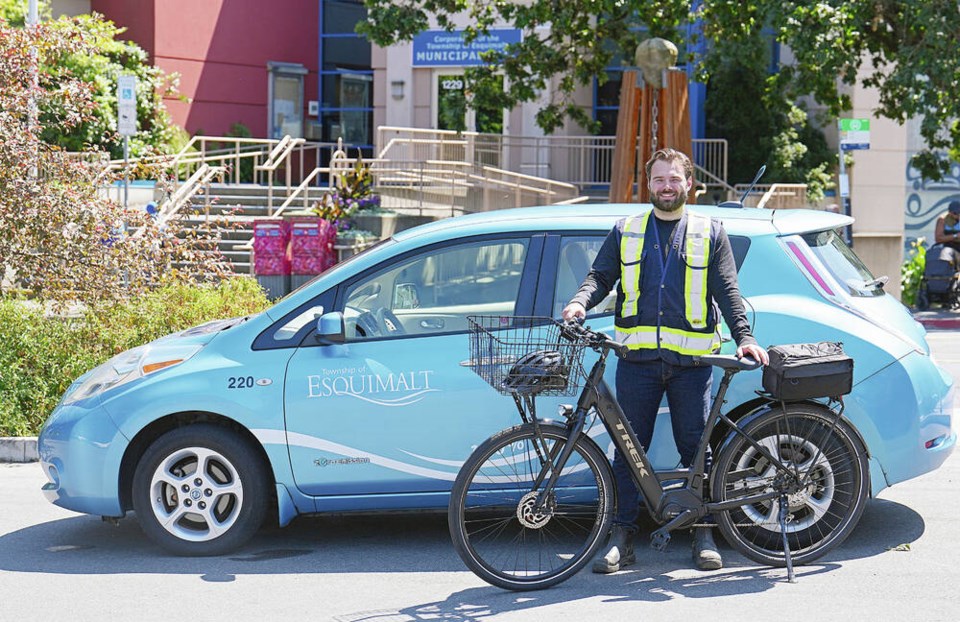Esquimalt could be getting its first electric-powered dump truck in the next four years.
A recently introduced fleet electrification plan could see 22 of the town’s 38 vehicles in its public works and parks departments replaced with electric vehicles by 2038.
“I think all of council were really impressed [with the plan],” said Mayor Barb Desjardins. “It was a unanimous vote to move it forward.”
Once a vehicle-charging plan is in place, “there is nothing stopping us” from moving forward with replacing the vehicles with all-electric versions, Desjardins said.
There’s currently only one electric vehicle in use by Esquimalt staff — a 2012 Nissan Leaf used to travel between work sites, meetings and township facilities, said Esquimalt spokeswoman Tara Zajac.
Steven Weibe, Innotech Fleet Strategies founder and managing director, who worked on Esquimalt’s fleet electrification plan, said while many of the electric vehicles used by municipalities are available on the commercial market, some used by public works departments are more specialized — such as garbage trucks — and have a more limited market.
As a result, the technology for heavy-duty electric vehicles is not as mature as for lighter vehicles, he said.
In Esquimalt, a garbage truck and a street sweeper planned for replacement this year will still feature a diesel combustion engine, township staff told council.
But despite the challenges, many B.C. municipalities are looking at how they can electrify their more emission-intensive vehicles, such as dump trucks and snow plows, said Weibe. “We’re seeing a renewed push for some of the more heavy-medium and heavy vehicles.”
There are only a handful of electric garbage trucks in Canada and most of them are in B.C. Squamish has one, and Burnaby council approved $1 million to purchase one this year.
The garbage truck operating in Squamish had its chassis built at Mack Trucks in Pennsylvania and its body built at Labrie Automizer in Quebec. The Burnaby truck will be supplied by B.C.-based Rollins Machinery Limited.
Electric vehicles may have larger upfront costs, but the overall maintenance costs are lower, Weibe said. “They have less moving parts, they have less fluid that needs to be changed,” he said, adding electricity is also less costly than gasoline or diesel.
“When you overlay some of these incentives that are out there from the provincial and federal government, it helps to offset that even more.”
Weibe said B.C., in particular, has “very good” incentives for electric vehicles. B.C. Hydro is offering to pay for 50 per cent of consultant costs for any private or public organization looking to start their own fleet-electrification plan, he said.
That allows for B.C. Hydro to start to get some of the data on energy used by vehicles that are going to be converting to electric.
The rising demand for expertise was enough for Weibe to quit his job as a fleet manager with the District of Saanich and start his own consultancy firm.
“I saw there was a big surge of work coming into this industry and I just thought it was a good opportunity,” said Weibe, who counts the municipalities of Saanich, Central Saanich, Qualicum Beach and Port Hardy among his clients.
Rowan Waldron, a sustainability project delivery manager at Saanich, said the district is looking to have a zero-emission vehicle fleet by 2040.
Saanich’s 350-strong vehicle fleet is already 12 per cent electric, mainly in light-duty vehicle categories such as passenger vehicles, pickup trucks and electric cargo vans, he said.
Staff are happy with the vehicles, especially the new electric pickup trucks, which allow for construction tools to be plugged in and batteries to be charged on the go, Waldron said.
A report on how Saanich can decarbonize its medium and heavy-duty vehicles is expected to come before council late this year, he said.
The district has a corporate climate plan goal of zero emissions by 2040, Waldron said, and the fleet strategy will be an important part of achieving that goal.
Waldron noted that others in the region have also been moving forward with their own plans.
The Capital Regional District added electric vehicles, hybrid electric vehicles, and hydrogen fuel cell electric vehicles to its fleet in 2017 and plans to have a fully electric light-duty vehicle and truck fleet by 2040.
Victoria intends to have 80 per cent of its municipal fleet electrified or renewably powered by 2040. In June, the Victoria Fire Department welcomed its first Austrian-made electric fire truck, becoming one of three fire departments in Canada that operate one.
It’s not just about heavy-duty vehicles like garbage trucks. In July, Esquimalt purchased an e-bike, with plans to buy another.
Braylon Lumb, an engineering project co-ordinator with Esquimalt said that a regular bike was already a convenient way to get around for staff without adding another car to the road.
“But with the e-bike, I can transport more equipment quicker and easier while keeping the advantages of a bicycle.”
>>> To comment on this article, write a letter to the editor: [email protected]



